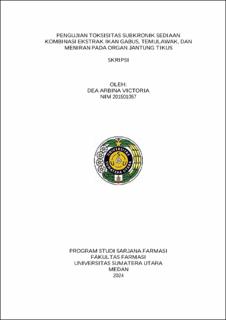| dc.description.abstract | Background: At the jamu level, the grade can be increased to OHT by adding pre-clinical test data, which includes efficacy and safety. This study is conducted to proof a combination of extracts of Channa striata, Phyllantus niruri, and Curcuma xanthorrhiza safety by subchronic test in rats to support it’s evidence. Subchronic toxicity studies are carried out to obtain information on the toxic effects of substances that were not detected in the acute toxicity test, information on the possibility of toxic effects after repeated exposure to the test product over a certain period, information on doses that do not cause toxic effects (No observed adverse effect level/ NOAEL) and study the existence of cumulative effects and reversible effects of certain substances. The NOAEL (No Observed-Adverse Effect Level) value through observation of death and toxic symptoms through a 14-day short oral subchronic test in rodents is 1,000 mg/kg BW
Objective: To identify the toxicity effect of long term consump of combination of sneakhead fish, curcuma, and phyllantus.
Method: Using 70 rats that determine for 6 group. 3 of them will given the extratc combination with 3 variating dose (1000 mg/KgBB, 300 mg/KgBB, 100 mg/KgBB), one of them will given CMC Na0,5% fot the control, 2 of them will given CMC na 0,5% and the hih dose for 90 days and would be stopped after that and we will looking for the probability of reverse effect in 28 days without any treatment. In the end of the treatment, all the rats will be sacrified to get their heart and blood serum for the clinical biochemical test, macropathology test, relative weight test, and histopathological test.
Results: From all the testing group, there are no differential of each group. From the clinical biochemical test, macropathology investigation, heart relative weight, and histopathological test there are no differential beetwen the control group, satelit group, and dosing group
Conclusion: The combination extract og sneakheadfish, curcuma, and phyllantus given no detected toxic effect in subchronic testing for the heart. | en_US |


